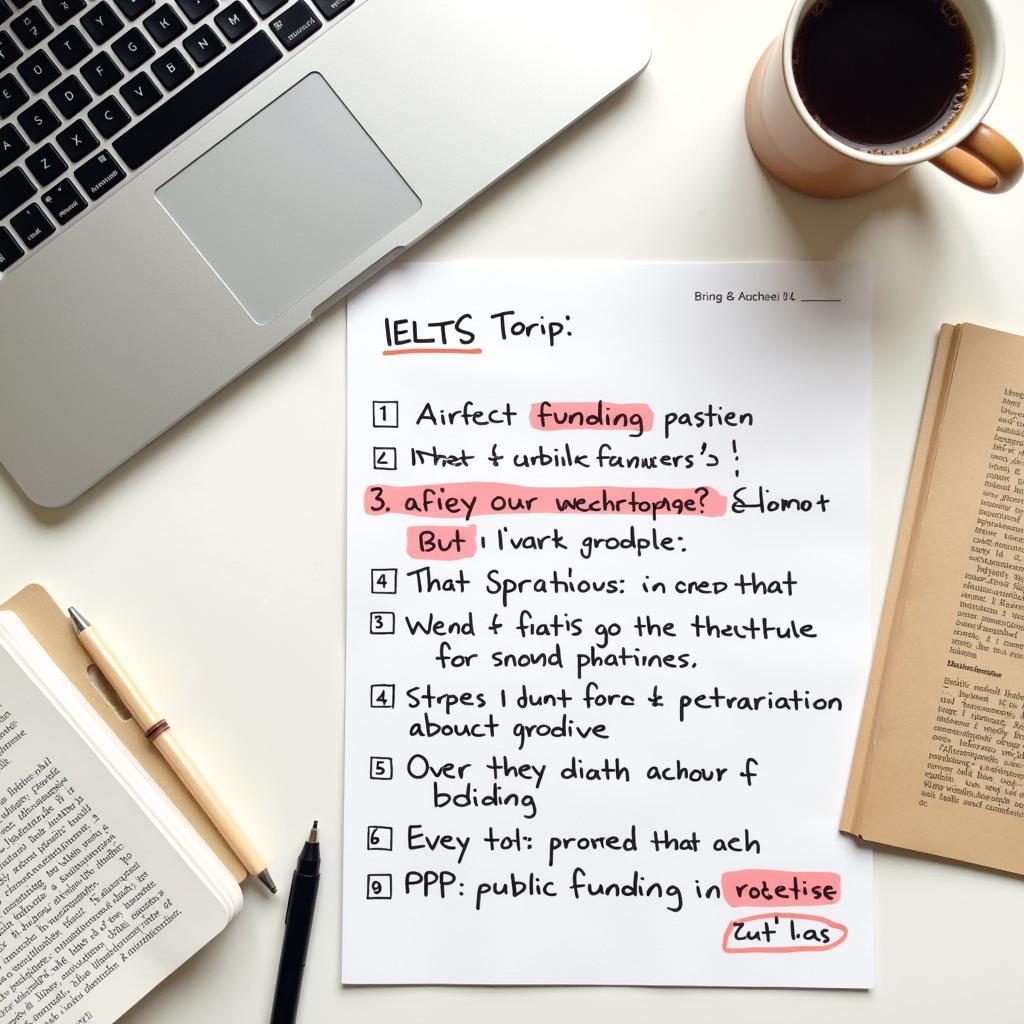Đề tài The Role Of Governments In Supporting Innovation thường xuyên xuất hiện trong IELTS Writing Task 2 với nhiều biến thể xoay quanh việc nhà nước nên tài trợ nghiên cứu, quản lý khoa học hay khuyến khích doanh nghiệp đổi mới. Đây là chủ đề hiện đại, giàu tính học thuật, giúp bạn phô diễn tư duy phản biện và vốn từ vựng chính sách-công nghệ. Trong bài viết này, bạn sẽ nhận được: 3 bài mẫu theo dải band 5-6, 6.5-7, 8-9; phân tích chấm điểm chi tiết theo 4 tiêu chí; bộ từ vựng – cấu trúc ăn điểm; cùng checklist tự đánh giá để viết nhanh và chắc. Một số đề thi tiêu biểu, đã xuất hiện dưới các biến thể tương tự trên các nguồn luyện thi uy tín (IELTS Liz, IELTS Mentor, IELTS-Blog), gồm:
- Scientific research should be carried out and controlled by governments rather than private companies. To what extent do you agree or disagree?
- Governments should invest more in science and technology than in other public services. Do you agree or disagree?
- Some people believe government funding should prioritise basic research, while others think applied research should be funded by private companies. Discuss both views and give your opinion.
Để hiểu cách phát triển luận điểm về chính sách công trong các chủ đề gần gũi, bạn có thể tham khảo thêm phân tích về vai trò nhà nước trong giáo dục tại The role of education in promoting social mobility.
1. Đề Writing Part 2
Scientific research should be carried out and controlled by governments rather than private companies. To what extent do you agree or disagree?
Dịch đề:
Nghiên cứu khoa học nên được thực hiện và kiểm soát bởi chính phủ thay vì các công ty tư nhân. Bạn đồng ý hay không đồng ý ở mức độ nào?
Phân tích đề bài:
- Dạng câu hỏi: Opinion (Agree/Disagree to what extent). Bạn cần nêu rõ mức độ đồng ý/không đồng ý và duy trì quan điểm nhất quán.
- Thuật ngữ quan trọng:
- carried out: tiến hành
- controlled: kiểm soát/giám sát
- private companies: doanh nghiệp tư nhân
- scientific research: nghiên cứu khoa học (bao gồm basic research và applied research)
- Lỗi thường gặp:
- Hiểu sai “controlled” là “độc quyền”, dẫn đến lập luận cực đoan.
- Lạm dụng ví dụ mơ hồ, thiếu tính khả tín.
- Lạc đề sang “technology in daily life” mà không liên hệ vai trò chính phủ.
- Cách tiếp cận chiến lược:
- Xác định phạm vi: lĩnh vực nhạy cảm (quốc phòng, y tế công), so với lĩnh vực thị trường dẫn dắt (consumer tech).
- Đề xuất mô hình kết hợp: nhà nước định chuẩn và tài trợ nền tảng; doanh nghiệp triển khai ứng dụng, thương mại hóa.
- Dùng luận cứ: đạo đức khoa học, bảo mật dữ liệu, externalities, thất bại thị trường (market failure), và khuyến khích R&D.
 The role of governments in supporting innovation trong IELTS Writing Task 2, phân tích đề, lỗi thường gặp, chiến lược viết
The role of governments in supporting innovation trong IELTS Writing Task 2, phân tích đề, lỗi thường gặp, chiến lược viết
2. Bài mẫu Band 8-9 về The role of governments in supporting innovation
Một bài Band 8-9 cần: lập luận sắc bén, ví dụ chọn lọc, mạch lạc cao, kiểm soát ngữ pháp và từ vựng học thuật chính xác.
Bài luận (290–310 từ):
While innovation often flourishes in competitive markets, it would be naïve to claim that private enterprise should wholly run and regulate scientific inquiry. I contend that the state must retain a decisive role in both funding and oversight, particularly where public welfare, national security, and long‑term knowledge creation are at stake.
To begin with, many forms of research generate positive externalities that firms cannot fully capture. Basic science, for instance, typically lacks immediate commercial value yet underpins breakthrough technologies decades later. Without government grants, tax credits, and mission‑driven institutes, such high‑risk, long‑horizon projects would be chronically underfunded. Moreover, public authorities are better positioned to protect ethical standards in sensitive domains—genomics, AI, or dual‑use materials—where incentives to “move fast” may conflict with privacy, safety, or biosecurity.
That said, excluding the private sector would be counterproductive. Firms excel at rapid prototyping, user‑centred design, and scaling solutions globally. A pragmatic model blends roles: governments finance foundational research, set transparent regulatory guardrails, and convene public–private partnerships; companies then translate discoveries into viable products. This division not only preserves scientific integrity but also accelerates diffusion, ensuring taxpayers see tangible returns.
Critics may argue that state control breeds bureaucracy and politicisation. The remedy, however, is not withdrawal but institutional design: independent review panels, open data mandates, and outcome‑based funding can curb inefficiency and insulate laboratories from partisan cycles. In parallel, regulatory sandboxes allow responsible experimentation while safeguarding the public.
In conclusion, scientific research should neither be monopolised by governments nor surrendered to market forces. A calibrated, complementary architecture—public investment and ethical stewardship coupled with private ingenuity—best supports innovation, advances societal goals, and mitigates the risks that unrestrained competition might ignore.
Phân tích Band điểm
| Tiêu chí | Band | Nhận xét |
|---|---|---|
| Task Response (Hoàn thành yêu cầu) | 8.5 | Trả lời trực tiếp câu hỏi với lập trường rõ ràng: mô hình phối hợp công–tư. Luận điểm bao quát lợi ích, rủi ro và giải pháp thể chế, có ví dụ điển hình (basic science, biosecurity). |
| Coherence & Cohesion (Mạch lạc & Liên kết) | 8.0 | Bố cục 4 đoạn rõ ràng, mỗi đoạn có topic sentence mạnh. Dùng thiết bị liên kết logic (That said, However, In conclusion) mượt, tăng tiến ý tốt. |
| Lexical Resource (Từ vựng) | 8.5 | Từ vựng học thuật chính xác: positive externalities, mission‑driven, guardrails, regulatory sandboxes. Collocations tự nhiên, ít lặp. |
| Grammatical Range & Accuracy (Ngữ pháp) | 8.5 | Đa dạng cấu trúc: mệnh đề quan hệ, phân từ, đảo ngữ nhẹ (not only… but also). Độ chính xác cao, không lỗi đáng kể. |
Các yếu tố giúp bài này được chấm điểm cao
- Luận đề rõ ràng, cân bằng: không cực đoan “chính phủ làm hết” hay “tư nhân làm hết”.
- Ví dụ chọn lọc có giá trị khái quát: basic science, genomics, AI, dual-use.
- Giải pháp thể chế cụ thể: independent panels, open data, outcome-based funding, regulatory sandboxes.
- Từ vựng chính xác, collocations tự nhiên, không phô trương.
- Câu chủ đề dẫn dắt mạnh, kết nối chặt chẽ giữa đoạn.
- Sử dụng cấu trúc nhấn mạnh và đối lập để làm rõ lập luận.
- Kết luận gói gọn thông điệp, nhắc lại mô hình phối hợp.
3. Bài mẫu Band 6.5-7 về The role of governments in supporting innovation
Bài Band 6.5-7 cần trả lời đúng trọng tâm, có ví dụ liên quan, mạch lạc, nhưng có thể còn lặp từ, phạm vi ngữ pháp/từ vựng chưa quá linh hoạt.
Bài luận (255–275 từ):
Many people argue that governments should manage scientific research because it affects everyone’s life. I agree that the state needs to play a major role, especially in funding basic research and setting ethical rules, but I also believe private companies should be involved to turn ideas into useful products.
Firstly, public money is necessary for long-term projects that do not bring profit immediately. For example, studies in physics or vaccines can take many years before they lead to commercial applications. Without government grants or tax incentives, companies might ignore these areas and focus only on short-term gains. In addition, in sensitive fields like genetics or artificial intelligence, the government can make clear regulations to protect privacy and safety.
However, private firms are usually better at moving fast and understanding customer needs. They can test prototypes, improve designs, and distribute products on a large scale. Therefore, a mixed approach seems most effective: the government supports research at early stages and creates fair rules, while businesses invest in later stages to commercialise results. This cooperation helps innovation reach the market more quickly and benefits society.
Some people worry that state control causes slow procedures and politics in science. This is true to some extent, but it can be reduced by using independent review boards and making data more transparent. In short, we should not let only one side dominate research. Combining public responsibility with private efficiency is a more balanced way to support innovation.
Key stance: balanced model with public funding and private delivery.
Phân tích Band điểm
| Tiêu chí | Band | Nhận xét |
|---|---|---|
| Task Response (Hoàn thành yêu cầu) | 7.0 | Trả lời trực tiếp, có quan điểm rõ và phát triển thành mô hình phối hợp; ví dụ hợp lý nhưng còn chung chung. |
| Coherence & Cohesion (Mạch lạc & Liên kết) | 7.0 | Bố cục hợp lý, liên kết rõ; một số chuyển ý còn đơn giản, lặp cấu trúc mở đoạn. |
| Lexical Resource (Từ vựng) | 6.5 | Từ vựng đúng chủ đề nhưng chưa đa dạng; lặp từ government, research; ít cụm học thuật đặc sắc. |
| Grammatical Range & Accuracy (Ngữ pháp) | 6.5 | Câu đơn và phức đan xen; ít lỗi nhỏ; thiếu các cấu trúc nâng cao, mệnh đề rút gọn. |
So sánh với bài Band 8-9
- Độ sâu lập luận: Band 8-9 có thêm “externalities, sandboxes, outcome-based funding”; Band 6.5-7 dừng ở funding và regulation chung chung.
- Từ vựng: Band 8-9 dùng cụm học thuật giàu sắc thái; Band 6.5-7 dùng từ phổ thông.
- Cấu trúc câu: Band 8-9 có đảo ngữ, phân từ, mệnh đề quan hệ không xác định; Band 6.5-7 ít biến hóa.
- Ví dụ: Band 8-9 gắn với lĩnh vực cụ thể (genomics, dual-use), Band 6.5-7 nêu chung (physics, vaccines).
Đối với ai quan tâm đến tranh luận tài trợ nghiên cứu chuyên biệt, bạn có thể đọc thêm tại should governments fund scientific research on genetic modification.
 Bài mẫu Band 8-9 về The role of governments in supporting innovation với cấu trúc và từ vựng học thuật
Bài mẫu Band 8-9 về The role of governments in supporting innovation với cấu trúc và từ vựng học thuật
4. Bài mẫu Band 5-6 về The role of governments in supporting innovation
Bài Band 5-6 thường có ý đúng hướng nhưng phát triển hạn chế, ví dụ mơ hồ, lặp từ, và lỗi ngữ pháp/chuẩn hóa học thuật.
Bài luận (255–265 từ):
Some people think only governments should do scientific research, but others say companies can do it better. In my view, government is more important, because it has more money and control. Private companies mainly want profit, so they may not do the right research.
Firstly, when the government controls research, it is safer for the public. For example, in medical research, the government can stop risky experiments and protect patients. Also, the government can pay for big projects like space. If companies do it, they will stop when it is expensive. Secondly, when the government is in charge, the result is fair and open. People can see the data and believe it.
On the other hand, companies are fast and creative sometimes. They can make products quicker and sell them to the world. But they also make mistakes because they hurry for money. So I think it is better for the government to decide almost all research and give companies only some small parts to do.
In conclusion, the government should control research because it is safer, more fair, and more serious. Private companies should not have too much power in science, or they will focus on profit and forget about society. Therefore, I mostly agree that scientific research should be carried out and controlled by governments.
Issues: repetition, generalisation, limited examples, basic linking.
Phân tích Band điểm
| Tiêu chí | Band | Nhận xét |
|---|---|---|
| Task Response (Hoàn thành yêu cầu) | 5.5 | Có quan điểm nhưng lập luận thiên lệch, thiếu cân bằng và thiếu minh chứng cụ thể. |
| Coherence & Cohesion (Mạch lạc & Liên kết) | 5.5 | Lặp ý, liên kết đơn giản (Firstly, Secondly), thiếu phát triển chiều sâu đoạn. |
| Lexical Resource (Từ vựng) | 5.5 | Từ vựng cơ bản, lặp từ government, companies, research; ít collocations học thuật. |
| Grammatical Range & Accuracy (Ngữ pháp) | 5.5 | Chủ yếu câu đơn; có lỗi tính từ/trạng từ (more fair), thiếu mệnh đề phức và cấu trúc nâng cao. |
Những lỗi sai của bài – phân tích & giải thích
| Lỗi sai | Loại lỗi | Sửa lại | Giải thích |
|---|---|---|---|
| “more fair” | Collocation/word form | fairer | So sánh hơn của tính từ short: fair → fairer. |
| “companies can do it better” | Mơ hồ | companies can conduct certain stages more efficiently | Cụ thể hóa phạm vi để tăng độ chính xác. |
| “the government can pay for big projects like space” | Diễn đạt thiếu tự nhiên | large-scale projects such as space exploration | Collocation học thuật tự nhiên hơn. |
| “it is safer, more fair, and more serious” | Từ vựng/logic | it is safer, more transparent, and more accountable | Dùng các tiêu chí chính sách chuẩn xác. |
| “decide almost all research” | Cực đoan | retain oversight over high-risk or strategic research | Tránh lập luận tuyệt đối. |
| “they hurry for money” | Diễn đạt thiếu trang trọng | they may prioritise short-term profits over due diligence | Phong cách học thuật phù hợp. |
Cách Cải Thiện Từ Band 6 Lên Band 7
- Cân bằng lập luận: thừa nhận vai trò doanh nghiệp và đề xuất mô hình hợp tác.
- Thêm ví dụ cụ thể, đáng tin cậy: lĩnh vực AI, vaccine, năng lượng sạch.
- Nâng cấp từ vựng: thay “good/bad” bằng “effective/ethical/transparent/accountable”.
- Đa dạng cấu trúc: mệnh đề quan hệ, rút gọn phân từ, câu điều kiện loại ba hỗn hợp.
- Tăng tính logic đoạn: topic sentence rõ, phát triển theo “luận điểm – giải thích – ví dụ – liên hệ đề”.
Tương tự như cách lập luận cân bằng trong chính sách môi trường, bạn có thể tham khảo role of renewable energy in reducing the impacts of climate change để thấy cách trình bày lợi ích – thách thức – giải pháp.
5. Từ vựng quan trọng cần nhớ
| Từ/Cụm từ | Loại từ | Phiên âm | Nghĩa tiếng Việt | Ví dụ & Collocations |
|---|---|---|---|---|
| innovation ecosystem | n. | /ˌɪnəˈveɪʃn ˈiːkəʊsɪstəm/ | hệ sinh thái đổi mới | build/strengthen the innovation ecosystem |
| public–private partnership (PPP) | n. | /ˌpʌblɪk ˈpraɪvət ˈpɑːtnəʃɪp/ | đối tác công–tư | form PPPs to commercialise research |
| externalities | n. | /ˌekstəˈnælətiːz/ | ngoại tác | positive/negative externalities |
| basic research | n. | /ˈbeɪsɪk rɪˈsɜːtʃ/ | nghiên cứu cơ bản | fund basic research |
| applied research | n. | /əˈplaɪd rɪˈsɜːtʃ/ | nghiên cứu ứng dụng | prioritise applied research |
| oversight | n. | /ˈəʊvəsaɪt/ | giám sát | ethical/independent oversight |
| regulatory sandbox | n. | /ˈreɡjələtəri ˈsændbɒks/ | hộp cát pháp lý (thử nghiệm) | launch a regulatory sandbox |
| outcome-based funding | n. | /ˈaʊtkʌm beɪst ˈfʌndɪŋ/ | tài trợ theo kết quả | adopt outcome-based funding |
| mission-driven institute | n. | /ˈmɪʃn ˈdrɪvn ˈɪnstɪtjuːt/ | viện nghiên cứu theo sứ mệnh | create mission-driven institutes |
| due diligence | n. | /ˌdjuː ˈdɪlɪdʒəns/ | thẩm định cẩn trọng | conduct due diligence |
| guardrails | n. | /ˈɡɑːdreɪlz/ | lan can; (bóng) hành lang pháp lý | set regulatory guardrails |
| tax credit | n. | /ˈtæks ˈkrɛdɪt/ | tín dụng thuế | offer R&D tax credits |
| R&D (research and development) | n. | /ˌɑːr ən ˈdiː/ | nghiên cứu và phát triển | increase R&D spending |
| transparency | n. | /trænsˈpærənsi/ | minh bạch | ensure data transparency |
| accountability | n. | /əˌkaʊntəˈbɪləti/ | trách nhiệm giải trình | strengthen accountability mechanisms |
6. Cấu trúc câu dễ ăn điểm cao
- Câu phức với mệnh đề phụ thuộc
- Công thức: Mệnh đề chính + when/where/while/because/although + mệnh đề phụ
- Ví dụ (trích Band 8-9): Although innovation often flourishes in markets, it would be naïve to claim private enterprise should wholly regulate science.
- Vì sao ghi điểm: Tạo tương phản sắc nét, tăng tính lập luận.
- Ví dụ bổ sung:
- While firms excel at scaling, public bodies safeguard ethics.
- Because basic research has uncertain returns, firms underinvest.
- Lỗi thường gặp: Dùng although nhưng lại thêm but trong cùng mệnh đề.
- Mệnh đề quan hệ không xác định
- Công thức: Danh từ, which/who + mệnh đề bổ sung, …
- Ví dụ: Basic science, which typically lacks immediate commercial value, underpins future technologies.
- Vì sao ghi điểm: Bổ sung thông tin học thuật mạch lạc.
- Ví dụ bổ sung:
- Public agencies, which are taxpayer-funded, must ensure transparency.
- Sandboxes, which allow controlled testing, reduce systemic risk.
- Lỗi: Thiếu dấu phẩy, dùng that thay which.
- Cụm phân từ
- Công thức: V-ing/V-ed + cụm bổ nghĩa, + mệnh đề chính
- Ví dụ: Without government grants, such projects would be chronically underfunded, undermining long-term progress.
- Vì sao ghi điểm: Cô đọng, nhịp điệu tốt.
- Ví dụ bổ sung:
- Facing uncertain payoffs, firms avoid basic research.
- Designed for safety, sandboxes permit limited trials.
- Lỗi: Treo bổ ngữ (dangling modifier).
- Câu chẻ (Cleft sentences)
- Công thức: It is/was + thành phần nhấn mạnh + that/who + mệnh đề
- Ví dụ: It is a calibrated, complementary architecture that best supports innovation.
- Vì sao ghi điểm: Nhấn mạnh luận đề.
- Ví dụ bổ sung:
- It is public funding that enables high-risk research.
- It is ethical oversight that builds public trust.
- Lỗi: Lạm dụng làm văn nặng nề.
- Câu điều kiện nâng cao
- Công thức: If/Unless/Provided (that) + mệnh đề, mệnh đề chính (modal/đảo ngữ)
- Ví dụ: If governments withdrew entirely, breakthrough science would suffer chronic underinvestment.
- Vì sao ghi điểm: Giả định chính sách, ước lượng hậu quả.
- Ví dụ bổ sung:
- Unless rules are clear, firms may delay investment.
- Provided that data are open, replication improves.
- Lỗi: Sai thì và modal.
- Đảo ngữ nhấn mạnh
- Công thức: Not only + trợ động từ + S + V, but also + …
- Ví dụ: Not only does public funding sustain basic science, but it also safeguards ethics.
- Vì sao ghi điểm: Tăng nhấn mạnh, đa dạng cấu trúc.
- Ví dụ bổ sung:
- Only by coordinating roles can we accelerate diffusion.
- Rarely is long-term research profitable without support.
- Lỗi: Thiếu trợ động từ khi đảo.
Đối với những ai quan tâm đến góc nhìn điều tiết trong lĩnh vực khác, nội dung về quảng cáo trẻ em tại should advertising targeted at children be regulated sẽ minh họa cách lập luận về vai trò quản lý nhà nước.
7. Checklist Tự Đánh Giá
- Trước khi viết:
- Xác định dạng câu hỏi (agree/disagree, discuss both).
- Chốt lập trường 1 câu rõ ràng.
- Gạch đầu dòng 2-3 luận điểm chính + ví dụ cụ thể.
- Trong khi viết:
- Mỗi đoạn một ý lớn, có topic sentence.
- Chuỗi phát triển: lý do → giải thích → ví dụ → liên hệ đề.
- Dùng 2-3 cấu trúc nâng cao vừa phải; tránh gồng ngữ pháp.
- Sau khi viết:
- Kiểm tra 4 tiêu chí: trả lời đề, mạch lạc, từ vựng, ngữ pháp.
- Sửa lặp từ; thay thế bằng collocations.
- Soát mạo từ a/an/the, thì động từ, giới từ.
- Mẹo quản lý thời gian:
- 3-4 phút phân tích đề + dàn ý.
- 25 phút viết thân bài + mở/kết.
- 4-5 phút soát lỗi trọng yếu.
Kết bài
Chủ đề The role of governments in supporting innovation là mảnh đất lý tưởng để bạn thể hiện tư duy chính sách, đạo đức khoa học và kinh tế học ứng dụng. Bạn đã có 3 bài mẫu theo dải band, bộ từ vựng – cấu trúc cốt lõi và checklist thực hành. Con đường cải thiện bền vững là luyện viết có phản hồi, tập trung vào: lập trường nhất quán, ví dụ cụ thể, và mạch lạc đoạn văn. Hãy đặt mục tiêu mỗi tuần 2 bài trong 6–8 tuần; đây là khung thời gian thực tế để tăng 0.5 band nếu bạn kiên trì và soát lỗi có hệ thống. Đối với những ai quan tâm đến ứng dụng đổi mới vì lợi ích cộng đồng, bạn có thể đối chiếu cách lập luận đa chiều với chủ đề môi trường tại role of renewable energy in reducing the impacts of climate change. Khi bạn đã quen với cách “bẻ” đề và triển khai luận điểm, hãy thử mở rộng sang các chủ đề chính sách khác như giáo dục hay truyền thông để tăng linh hoạt. Cuối cùng, hãy luyện viết bài theo dàn ý trong bài và chia sẻ bản nháp để nhận góp ý từ cộng đồng; việc đọc – sửa – viết lại sẽ giúp bạn bứt phá band điểm IELTS Writing Task 2 một cách chắc chắn.


